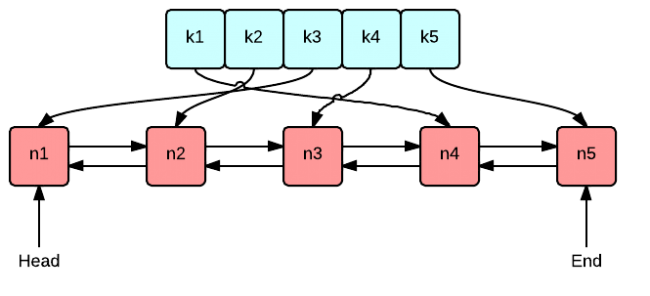LRU Cache
描述
Design and implement a data structure for Least Recently Used (LRU) cache. It should support the following operations: get and set.
get(key) - Get the value (will always be positive) of the key if the key exists in the cache, otherwise return -1.
set(key, value) - Set or insert the value if the key is not already present. When the cache reached its capacity, it should invalidate the least recently used item before inserting a new item.
分析
为了使查找、插入和删除都有较高的性能,这题的关键是要使用一个双向链表和一个HashMap,因为:
- HashMap保存每个节点的地址,可以基本保证在
O(1)时间内查找节点 - 双向链表能后在
O(1)时间内添加和删除节点,单链表则不行
具体实现细节:
- 越靠近链表头部,表示节点上次访问距离现在时间最短,尾部的节点表示最近访问最少
- 访问节点时,如果节点存在,把该节点交换到链表头部,同时更新hash表中该节点的地址
- 插入节点时,如果cache的size达到了上限capacity,则删除尾部节点,同时要在hash表中删除对应的项;新节点插入链表头部

代码
Java中也有双向链表LinkedList, 但是 LinkedList 封装的太深,没有能在O(1)时间内删除中间某个元素的API(C++的list有个splice(), O(1), 所以本题C++可以放心使用splice()),于是我们只能自己实现一个双向链表。
本题有的人直接用 LinkedHashMap ,代码更短,但这是一种偷懒做法,面试官一定会让你自己重新实现。
// LRU Cache
// 时间复杂度O(logn),空间复杂度O(n)
public class LRUCache {
private int capacity;
private final HashMap<Integer, Node> map;
private Node head;
private Node end;
public LRUCache(int capacity) {
this.capacity = capacity;
map = new HashMap<>();
}
public int get(int key) {
if(map.containsKey(key)){
Node n = map.get(key);
remove(n);
setHead(n);
return n.value;
}
return -1;
}
public void set(int key, int value) {
if (map.containsKey(key)){
Node old = map.get(key);
old.value = value;
remove(old);
setHead(old);
} else {
Node created = new Node(key, value);
if (map.size() >= capacity){
map.remove(end.key);
remove(end);
setHead(created);
} else {
setHead(created);
}
map.put(key, created);
}
}
private void remove(Node n){
if (n.prev !=null) {
n.prev.next = n.next;
} else {
head = n.next;
}
if (n.next != null) {
n.next.prev = n.prev;
} else {
end = n.prev;
}
}
private void setHead(Node n){
n.next = head;
n.prev = null;
if (head!=null ) head.prev = n;
head = n;
if(end == null) end = head;
}
// doubly linked list
static class Node {
int key;
int value;
Node prev;
Node next;
public Node(int key, int value) {
this.key = key;
this.value = value;
}
}
}